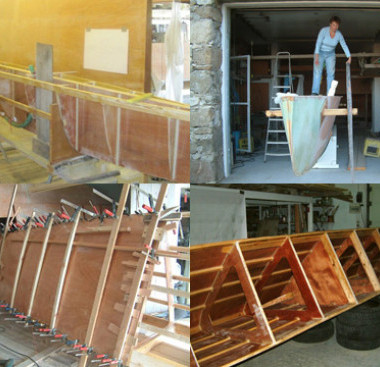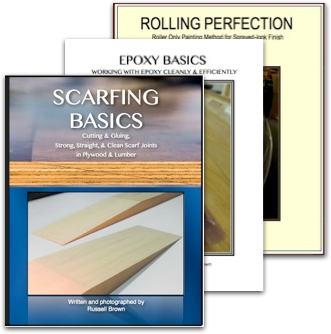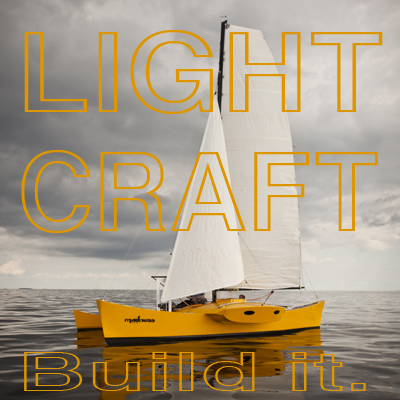A proa for Ariadne
Maestro proa designer John Dalziel has an interesting new project - an 8m proa “workhorse” for the Greek Isles.
On the Greek island of Naxos, fabled home of Dionysus and Ariadne, Helmut Mueller is building an 8 meter proa. Unusually for its size, it is actually a half-displacement model of a 10 meter proa Helmut intends to build. However, we decided it was best to build the 8 meter model first and test it thoroughly. Besides being a lot of fun, the 10 M proa is intended to be practical transportation between the islands of the Cyclades, with the ability to carry several hundred kg of cargo- so it needs to work, and work well.
This proa is laid out along the general lines of the Kiribati proas, with the famous “Kiribati dimple” in the lee side, and a 40 mm lateral camber to the keel. The only hydrodynamic innovation is the use of a “vortex tunnel” keel, which Dieter Shulz and John Dalziel developed some years ago, to get better windward speed from hulls without daggerboards. Dieter built and tested aerodynamic models which showed promising lift/drag characteristics, but as far as we know this will be the first full-size test of the concept.
The 25sm crab-claw sail is actually intended for the 10 M boat, but we are using it on the 8 M model to make sure a crew of one or two can handle it safely. If all goes well, this will be quite a fast proa.
After aeronautical engineer Janusz Ostrowski calculated the weight of wood spars for the boat, we decided to “bite the bullet” and build them from carbon fiber; handling the weight of the wood spars would quickly tire out the crew. Carbon should solve that problem, but I think we are near the practical limits for a crab-claw sail on a boat sailed by only two crew.
Helmut intends to experiment with rigs, including a mast step location to windward on a girder (shown on the three-view) or in the traditional position, plus the use of a lee shroud or a bungee-loaded back-wind brace. There is a step and partners fitted to the main hull that will allow the use of a free-standing mast. It is also possible to mount a marconi rig on the mast girder, in the manner of Russ Brown’s proas.
Helmut plans to use Gary Dierking’s bungee- assisted shunting system, and will test shunting using a free yard, a continuous shunting line, and if necessary, a full-length track-and-car system on deck. Spilling lines are used for sail control.
To avoid the usual problems with steering, we went with the tried-and-true long sweep. The sweep can be used on either side of the stern, though we intend at first to use Gary Dierking’s system on the windward side. There is a lot of extra reinforcement in the ends, to allow testing of quarter-rudders or leeboards.
Non-steering daggerboards and slots are built into the hull at either end; these will take the strain off the helmsman when sailing downwind, and will also allow the boat to be balanced when the Western-style rigs are tested.
There is a 255 liter water-ballast tank located in the ama, but design 75/25 weight distribution is achieved with only 80 liters of water. There are two pumps located at the cockpit to fill or drain the tank.
One trick we will try is to make the lee pod do double-duty as a dinghy. This is an old idea with several major problems, but we are going to see if we can make it work. The fixed pod of the 10 M proa is designed to right the boat from a static heel to leeward of 110 degrees. We won’t achieve such a deep angle with the dinghy-pod, but we will get self-righting to at least 100 degrees.
Specifications
- LOA- 8 M (26’4”)
- LWL- 7.518 M
- Ama LOA- 4.96 M
- Ama LWL- 4.82 M
- Beam Overall- 5.401 M
- Beam Hull- 0.883 M
- Hull BWL- 0.407 M
- Beam, Hull C/L to Ama C/L- 4.16 M
- Beam Ama- 0.377 M
- Ama BWL- 0.293 M
- Hull Draft- 0.488 M
- Ama Draft- 0.29 M
- Aka Clearance over flat water- 0.803 M
- Design Displacement, fully loaded, with crew, all equipment, and 80 liters water ballast- 640 kg
- Ama Water Ballast Capacity- 255 kg
- Design weight distribution- hull 75%, ama 25%
- Wt. dist, no water ballast- hull 85%, ama 15%
- Wt. dist, full water ballast- hull 60%, ama 40%
- Sail Area- 25 M2 (269 sq. ft.)
- Mast Length- 7-8 M
- Yard and Boom Length- 8.3 M
Design Credits
Overall concept, lines, general layout: John Dalziel
Construction design and methods: Helmut Mueller
Sail plan, spars and carbon fiber specifications: Janusz Ostrowski





Hello All!
I am new to this exciting world of exotic Proa craft and am
learning as much as I can. I have two questions that I hope
someone can respond to as I may not be the only person curious
about learning the answers to these:
1. ““Kiribati dimple” in the lee side, and a 40 mm lateral camber to
the keel.”
Question: Is the lee side “dimple” the natural consequence of the
40mm camber to the keel? Or is it deeper? Seeking a better mental
model of what is intended and been found practically useful.
I have found this reference which describes this implementation
in traditional Kiribti canoe fabrication:
http://clacabanne.free.fr/construction_bateaux.htm
2. Question: How can I learn more about: “the use of a “vortex
tunnel” keel, which Dieter Shulz and John Dalziel developed some
years ago”? I understand that some boats shed a vortex trail. I do
not yet understand the concept for a “vortex tunnel keel”.